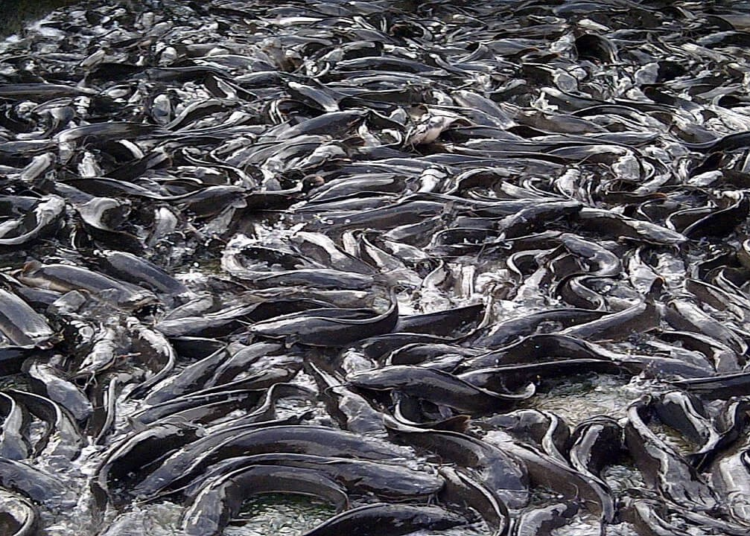Catfish farming is one of the easiest and fastest ways to make extra income.
Irrespective of your background, you can go into catfish farming as alternative means of making money as it can be done on a small scale or commercial production.
Fish farming, mostly catfish, is currently a very lucrative business and it is mainly boosted by the continuous rise in the demand for catfish, with many hospitality outfits springing up almost on a weekly basis. In hospitality industry, catfish is often use in pepper soup.
This is a business that can generate N200,000 or more monthly depending on how much it’s invested in it.
Dr Christopher Adetunji, a Catfish farmer based in Osun State, while speaking with LEADERSHIP noted that, catfish can be exported, smoked, dried or fried to one’s taste.
“Many people have today become big time exporters of catfish. With catfish, people have been travelling outside the country because there are customers outside the shore of Nigeria. We use to dry it or smoke it, then put it into properly packaged nylon for export. We have many buyers even within Nigeria based on it’s nutrients,” he stressed.
According to Adetunji, rearing catfish is very easy because it is friendly to many water. For someone who wants to go into catfish, you can get a useless empty water tanker or drum within your compound. Even if you have concrete yard, get some fingerlings of catfish into the drum or water tanker, pour some water into it, then pit the fingerlings into that water. But ensure there is a way to filter the water, on a regular basis. When using drum or tanker, drill a pipe where you can be releasing the water while you pump in fresh water.”
Furthermore, Adetunji explained that, it usually take four to five months from fingerlings to get into matured stage, adding that, starting a catfish farming business requires effort, dedication, and most importantly passion.
To him, “one can start with a plastic pond because it is cheaper as all you have to do is to buy the already made pond and set it up with good plumbing and waterworks. One can get ponds. A good water source like the borehole should be considered. But Catfish become stressed when key water quality parameters such as temperature, pH, alkalinity, hardness nitrogenous waste, dissolved oxygen and salinity are not kept within specified thresholds.”
‘It is more advisable to know the quality of your water source and one should have testing equipment to test the water,’ he stressed.
He admonished that, “the measure of the alkalinity or acidity of water is expressed by its pH value. The pH value ranges from 0 to 14, with pH 7 indicating that the water is neutral, while a value smaller than 7 indicate acidity and a value greater than 7 notes alkalinity. Fish production can be greatly affected by excessively low or high pH.
“Catfish becomes ready for sale when it has an average weight size of 300 to 400 grams. This is called the mélange production, the raising of catfish from fingerlings to three months to meet the size for those that smoke and sell.”
n the same vein, another expert in catfish, Mrs Akume Audu, said, catfish is one of the easiest fish production one can farm in.
To her, “anyone willing to go into catfish farming in Nigeria, should look for conducive environment and get fingerlings. The fingerling can be obtained mainly through artificial propagation in the hatcheries through hormonal induction.”
If you intend to produce your own fertilized eggs, you can make use of the homoplastic pituitary gland suspension. It is usually more affordable than the imported hormonal analogues. Catfish is more reliable in term of growth and marketability.”
But one should know the risk involved before going into it, which includes problem of cannibalism, heavy predation by frogs/aquatic insects and the abiotic challenges such as water temperature.
“If you intend to culture the fingerling outdoor, you should take into consideration the prevalence of predatory insects in Nigeria. Therefore, ensure you cover the tanks with mosquito nets so as to keep the predatory insects away.
“You should be able to know how to use indoor water re-circulatory system (WRS). But it is costlier, so most simply use the concrete tanks.”
According to her, “on feeding, you must be prepare to feed them at designated time of the day. The feed you are offering must contain the essential amino acids such as arginine, methionine and lysine found in crude protein sources.
“The richest source of crude protein for this purpose is fishmeal. But due to its high cost, it is advisable not to go for it (i.e. if you are just starting out). Instead, you can use other conventional and sometimes unconventional animal by-products as well as plant residue (such as groundnut cake, soyabean cake etc.) that meet the nutrient requirements of catfish.”
In addition, she said, this is in order to minimise cost of production as much as possible.
“Through development of fish farming over the years in Nigeria, feeding of catfish is predominantly done using pelleted floating feeds. This ensures adequate feeding of the fish thus increased growth rate.”
“When feeding, it is advisable to do it on a particular part of the pond instead of just scattering the feed across the water surface. This helps to minimize wastage of feed.”




